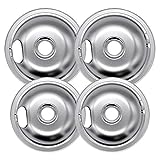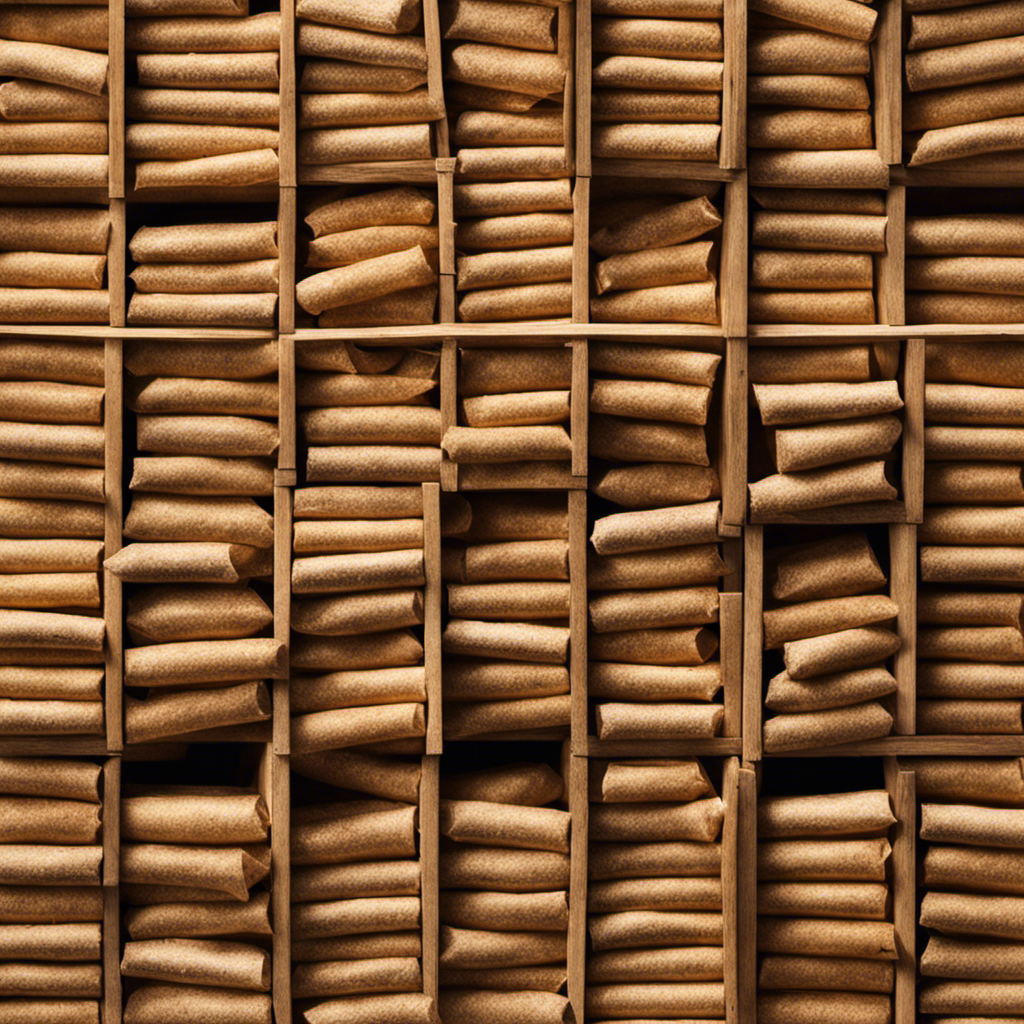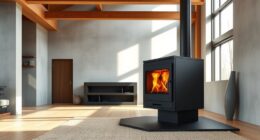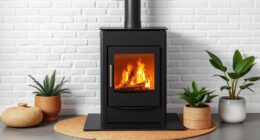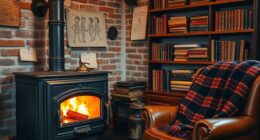I’ve always been fascinated by the method of smoking food, and recently, I’ve discovered the wonders of using a vertical wood pellet smoker.
If you’re like me and love the rich, smoky flavors that come from this cooking method, then you’re in for a treat.
In this article, I’ll guide you through the ins and outs of using a vertical wood pellet smoker, from choosing the right wood pellets to monitoring and maintaining the perfect temperature.
Get ready to elevate your BBQ game to new heights!
Key Takeaways
- The vertical wood pellet smoker combines indirect heat and wood pellets to provide a consistent and flavorful cooking experience.
- Choosing the right wood pellets for smoking involves considering flavor profiles, heat and smoke production, and compatibility with the type of food being smoked.
- Proper maintenance and cleaning of the smoker, including checking the hopper, emptying the ash pan, and cleaning the grates, ensures optimal performance and longevity.
- Temperature and airflow control techniques, such as adjusting vents and using dampers, are crucial for achieving desired cooking temperatures and smoke intensity.
Understanding the Vertical Wood Pellet Smoker
To understand the vertical wood pellet smoker, you’ll need to know how it functions and what sets it apart from other types of smokers. This type of smoker utilizes a unique system that combines both indirect heat and wood pellets to create a consistent and flavorful cooking experience.
The temperature control techniques used in vertical wood pellet smokers are highly advanced, allowing for precise adjustments to achieve the desired cooking temperature. This level of control ensures that your food is cooked evenly and to perfection every time.
Additionally, mastering the art of smoke production is essential when using a vertical wood pellet smoker. The smoker’s design ensures that the smoke circulates evenly around the food, imparting a delicious smoky flavor.
Now that you understand how the vertical wood pellet smoker works, let’s move on to choosing the right wood pellets for smoking.
Choosing the Right Wood Pellets for Smoking
When it comes to choosing the right wood pellets for smoking, there are a few key points to consider.
Firstly, you’ll want to think about the flavor profiles of different types of wood pellets, as they can greatly enhance the taste of your food.
Secondly, it’s important to understand the heat and smoke production of different pellets, as this can affect the cooking process and the overall flavor.
Lastly, you’ll want to ensure that the wood pellets you choose are compatible with the type of food you plan to smoke, as certain flavors and intensities work better with specific meats or vegetables.
Pellet Flavor Profiles
Different pellet flavor profiles, such as hickory, mesquite, and apple, can be used to enhance the taste of your smoked food. When it comes to flavor preferences, experimenting with pellets is key. Here are four popular pellet flavors and the taste they bring to your dishes:
-
Hickory: This classic flavor adds a strong, smoky taste to your food. It pairs well with beef, pork, and poultry, giving them a robust and savory flavor.
-
Mesquite: Known for its bold and intense flavor, mesquite pellets infuse your food with a distinct smokiness. It works great with red meats like steak and ribs, adding a rich and tangy flavor.
-
Apple: If you prefer a milder, slightly sweet flavor, apple pellets are a great choice. They complement poultry, pork, and fish, giving your dishes a subtle fruity undertone.
-
Cherry: Cherry pellets offer a slightly sweet and fruity flavor that works well with a variety of meats. They add a hint of sweetness without overpowering the natural flavors of the food.
Now that you know about different pellet flavor profiles, let’s move on to discussing heat and smoke production.
Heat and Smoke Production
Understanding how heat and smoke are produced in your smoker is essential for achieving the perfect flavor and tenderness in your smoked dishes. Heat management is crucial in controlling the cooking process and ensuring even and consistent cooking.
In a vertical wood pellet smoker, heat is generated by burning wood pellets, which are fed into the firebox by an automated auger system. The pellets are ignited by a hot rod, and the resulting flames and heat circulate inside the smoker, cooking the food.
Along with heat, smoke infusion is a key element in achieving that smoky flavor. Wood pellets produce smoke as they burn, and this smoke surrounds the food, imparting its delicious flavor.
Mastering the art of heat management and smoke infusion in your vertical wood pellet smoker will elevate your culinary creations to new heights of deliciousness and tenderness.
Now, let’s explore the compatibility of different foods with this cooking method.
Compatibility With Food
To achieve the best results with your dishes, it’s important to consider the compatibility of various foods with this cooking method. When using a vertical wood pellet smoker, the type of pellets you choose can greatly impact the flavor and outcome of your food. Different woods impart distinct flavors, so it’s crucial to match the right pellets with the food you’re smoking. Here’s a table to help you understand the pellet compatibility and smoking techniques:
| Food | Recommended Pellet | Smoking Technique |
|---|---|---|
| Beef | Mesquite | Low and slow |
| Chicken | Apple | Medium heat |
| Pork | Hickory | High heat |
| Fish | Alder | Indirect heat |
Preparing the Vertical Wood Pellet Smoker for Use
First, check the hopper of your vertical wood pellet smoker to ensure it is filled with the appropriate amount of wood pellets.
Maintaining and cleaning your vertical wood pellet smoker is essential for optimal performance and longevity. Here are three important steps for vertical wood pellet smoker maintenance:
-
Empty the ash pan: After each use, remove the ash pan and discard the accumulated ash. This prevents airflow obstruction and ensures consistent temperature control.
-
Clean the grates: Use a grill brush to remove any residue or buildup from the cooking grates. This promotes even heat distribution and prevents food from sticking.
-
Inspect the auger and fire pot: Check the auger and fire pot for any debris or blockages. Clear any obstructions to ensure proper pellet delivery and combustion.
Now that your vertical wood pellet smoker is well-maintained, you can move on to loading the wood pellets into the smoker, ensuring a flavorful and efficient cooking experience.
Loading the Wood Pellets Into the Smoker
When it comes to loading wood pellets into your smoker, it’s important to use proper techniques to ensure optimal performance and flavor.
Understanding the pellet capacity and storage options will also help you plan your smoking sessions more efficiently.
In this discussion, I will provide detailed information on the proper pellet loading techniques, as well as tips on how to store and manage your pellet supply effectively.
Proper Pellet Loading Techniques
Make sure you’re loading the wood pellets evenly in the hopper to ensure a consistent and efficient burn in your vertical wood pellet smoker.
Proper pellet storage is essential to maintain the quality and performance of your pellets. Always store them in a dry area, away from moisture and pests.
When it comes to loading the pellets, one common mistake is overfilling the hopper. This can lead to poor airflow and uneven burning.
Another mistake is not properly cleaning the hopper before refilling it with new pellets. Any leftover ash or debris can affect the burn and flavor of your food.
To avoid these issues, make sure to clean the hopper regularly and load the pellets in small, even amounts.
Now let’s move on to pellet capacity and storage, which plays a crucial role in maintaining the efficiency of your smoker.
Pellet Capacity and Storage
The capacity of your hopper determines how long you can smoke without needing to refill it. Maximizing pellet capacity is crucial for a smooth and uninterrupted smoking experience. Here are some pellet storage tips to help you make the most out of your smoker:
-
Keep pellets in a dry place: Moisture can ruin the pellets and affect their performance. Store them in airtight containers or bags to keep them dry.
-
Invest in a pellet storage system: Using a dedicated storage system, like a pellet dispenser or airtight container, can help you organize and protect your pellets.
-
Rotate your pellets: To prevent moisture and maintain freshness, it’s recommended to rotate your pellet stock. Use older pellets first to ensure optimal performance.
-
Consider pellet flavors: Different wood pellet flavors can enhance the taste of your smoked food. Experiment with different flavors to find your favorite.
By following these pellet storage tips, you can maximize your pellet capacity and ensure a continuous supply of smoke for your vertical wood pellet smoker.
Now, let’s move on to igniting the wood pellets in the smoker.
Igniting the Wood Pellets in the Smoker
To ignite the wood pellets in your smoker, you’ll want to ensure that the air vents are fully open. This allows for proper pellet ignition and ensures a consistent flow of oxygen to the fire.
Before loading the pellets into the smoker, it’s important to check for any blockages or obstructions in the air vents. Sometimes, pellets can get stuck or moisture can accumulate, causing issues with ignition.
If you’re having trouble igniting the pellets, you can try using a small torch or lighter to ignite a few pellets manually. Once the pellets are lit, close the smoker’s door and adjust the temperature and airflow to maintain the desired cooking temperature.
This will be discussed further in the next section about adjusting the temperature and airflow in the smoker.
Adjusting the Temperature and Airflow in the Smoker
When it comes to smoking meat, mastering temperature control and airflow adjustment are key to achieving the perfect cook.
Temperature control techniques involve using the smoker’s built-in thermostat or manual adjustments to maintain a consistent temperature throughout the cooking process.
Airflow adjustment methods, on the other hand, allow you to regulate the amount of oxygen that reaches the fire, controlling the intensity of the heat and the amount of smoke produced.
Understanding and implementing these techniques will ensure that your meat is cooked to perfection every time.
Temperature Control Techniques
One of the most effective techniques for controlling temperature on a vertical wood pellet smoker is by using the adjustable air intake vents. These vents allow you to regulate the flow of oxygen into the smoker, which in turn affects the temperature. By opening the vents wider, more oxygen is allowed in, resulting in a higher temperature. Conversely, closing the vents restricts the oxygen flow, leading to a lower temperature. It’s important to note that the temperature control tips discussed here may also help troubleshoot temperature fluctuations.
Here is a table summarizing the temperature control tips for your vertical wood pellet smoker:
| Temperature Control Tips |
|---|
| Open vents wider for higher temperature |
| Close vents for lower temperature |
| Monitor the temperature regularly |
| Adjust vents gradually for precise control |
Airflow Adjustment Methods
When it comes to using a vertical wood pellet smoker, controlling the airflow is crucial for achieving the desired smoke intensity and maintaining a consistent temperature. Here are three effective methods for adjusting the airflow:
-
Dampers: Most vertical wood pellet smokers have dampers located at the top and bottom of the unit. By opening or closing these dampers, you can regulate the amount of air entering and exiting the smoker, thus controlling the heat and smoke levels.
-
Ventilation Holes: Some models have additional ventilation holes on the sides or back. By adjusting these holes, you can fine-tune the airflow and customize the smoke intensity to your preference.
-
Chimney Cap: The chimney cap is another airflow control mechanism. By adjusting the cap’s position or using a damper on the chimney, you can further control the airflow and smoke intensity inside the smoker.
Now that we have mastered the airflow control, let’s move on to placing the food on the smoker racks.
Placing the Food on the Smoker Racks
To ensure proper cooking, it’s important to evenly distribute the food on the smoker racks. Proper food placement is crucial for maximizing smoker space and achieving consistent results. When placing the food on the racks, make sure there is enough space between each item to allow for proper airflow and even cooking.
Avoid overcrowding the racks, as this can lead to uneven cooking and longer cooking times. Place larger cuts of meat or items that require longer cooking times on the lower racks, while smaller items can be placed on the upper racks. By strategically arranging the food on the smoker racks, you can optimize the space available and ensure that every piece is cooked to perfection.
Now, let’s move on to monitoring and maintaining the smoker temperature.
Monitoring and Maintaining the Smoker Temperature
After placing the food on the smoker racks, it’s important to closely monitor and maintain the temperature of your vertical wood pellet smoker to ensure accurate cooking results.
To maintain temperature accuracy, start by preheating the smoker according to the manufacturer’s instructions. Once it reaches the desired temperature, carefully place the food inside and close the door. Keep an eye on the built-in thermometer to monitor the temperature.
However, it’s not uncommon to face temperature fluctuations during the cooking process. To troubleshoot these fluctuations, check if the smoker’s vents are open and adjust them accordingly. Additionally, ensure that the smoker’s seals are tight and not letting any heat escape.
By carefully monitoring and maintaining the smoker temperature, you’ll be able to achieve perfectly cooked and flavorful meals.
Now, let’s move on to the next step of adding wood pellets and water as needed.
Adding Wood Pellets and Water as Needed
Make sure you frequently check and replenish the wood pellets and water as necessary. Maintaining the proper amount of wood pellets and water in your vertical wood pellet smoker is crucial for successful smoking.
Here are some important points to keep in mind for wood pellet smoker maintenance:
-
Wood Pellets:
-
Use high-quality wood pellets specifically designed for smoking.
-
Check the pellet hopper regularly and add more pellets as needed.
-
Avoid using wet or damp pellets, as they can affect the temperature and smoke production.
-
Water:
-
Fill the water pan with clean water before each use.
-
Monitor the water level throughout the smoking process and refill as necessary.
-
Adding water helps regulate the temperature and creates moisture for tender, juicy smoked food.
Using wood pellets in your smoker offers several benefits, such as consistent heat distribution, enhanced flavor infusion, and minimal ash production.
Now, let’s move on to the next section about removing and serving the smoked food.
Removing and Serving the Smoked Food
Now that we’ve covered the process of adding wood pellets and water to the vertical wood pellet smoker, let’s move on to the next step: removing and serving the smoked food.
Once your food has reached the desired level of smokiness, it’s time to carefully remove it from the smoker. Using heat-resistant gloves or tongs, gently lift the food off the cooking grates and place it on a clean platter or cutting board. Allow the food to rest for a few minutes before serving to let the flavors fully develop.
When it comes to serving smoked food, presentation is key. Consider slicing larger cuts of meat against the grain for maximum tenderness, and garnish your dishes with fresh herbs or a squeeze of lemon for an extra touch of flavor.
Are the techniques for using a vertical wood pellet smoker the same as a regular wood pellet smoker?
Yes, the techniques for using a vertical wood pellet smoker are similar to a regular wood pellet smoker. Both require proper temperature control, wood pellet selection, and seasoning of the meat. However, the vertical smoker may have different airflow patterns, so it’s essential to familiarize yourself with its specific features.
Frequently Asked Questions
How Long Should I Soak the Wood Pellets Before Using Them in the Smoker?
I usually soak the wood pellets for about 30 minutes before using them in the smoker. Soaking helps to add moisture to the pellets, which creates more smoke and enhances the flavor of the food. Preheating the smoker is also important for optimal results.
Can I Use Regular Charcoal in a Vertical Wood Pellet Smoker?
Can I use regular charcoal in a vertical wood pellet smoker? While it’s technically possible, there are pros and cons to consider. Regular charcoal may provide a different flavor profile, but it can also produce more ash and require more frequent maintenance.
What Is the Ideal Temperature Range for Smoking Different Types of Meat?
The ideal smoking temperatures for different types of meat vary, but generally range from 225 to 275 degrees Fahrenheit. To maintain consistent heat, it’s important to regularly monitor and adjust the smoker’s temperature settings.
How Often Should I Check and Refill the Wood Pellet Hopper During a Long Smoking Session?
During a long smoking session, I check and refill the wood pellet hopper every 1-2 hours. This helps maintain a consistent temperature and ensures a steady flow of smoke for that delicious, smoky flavor.
Is It Necessary to Preheat the Smoker Before Adding the Food?
Preheating the smoker is not necessary, but it has its benefits. It helps to stabilize the temperature and ensures even cooking. Alternatively, you can start smoking immediately, but be aware of potential temperature fluctuations.
Conclusion
As I remove the perfectly smoked brisket from the vertical wood pellet smoker, a sense of anticipation fills the air. The aroma wafting from the meat is intoxicating, making it impossible to resist taking that first bite.
As I sink my teeth into the tender, smoky goodness, I am transported to a world of culinary delight. The journey from choosing the right wood pellets to monitoring the smoker temperature has paid off, resulting in a mouthwatering masterpiece.
With each bite, a deeper appreciation for the art of smoking emerges.
Growing up surrounded by the vast beauty of nature, Sierra was always drawn to the call of the wild. While others sought the comfort of the familiar, she ventured out, embracing the unpredictable and finding stories in the heartbeat of nature.
At the epicenter of every remarkable venture lies a dynamic team—a fusion of diverse talents, visions, and passions. The essence of Best Small Wood Stoves is crafted and refined by such a trio: Sierra, Logan, and Terra. Their collective expertise has transformed the platform into a leading authority on small wood stoves, radiating warmth and knowledge in equal measure.




